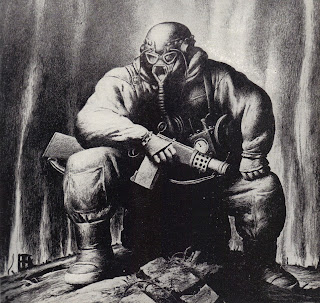This is a reply to the question:
Just how important is scientific accuracy in Palaeo-art? Is palaeontology, and by association those who follow the technical side of the science, becoming too judgemental towards the artistic efforts of palaeo-artists? This is an individual opinion on this topic.
To read a number of different peoples' answer to this question click this link here. If you have your own answer, read the last paragraph of this post for details on how to get yours posted on ART Evolved.

This post is brought to us by guest contributor Taylor Reints of the blog Beasts Evolved.
I've never really discussed palaeoart, or paleoart, which is the art (or science) of reconstructing, restoring, drawing, sculpting, painting and even animating prehistoric creatures before. We do know, however, that paleoart is restoring prehistory, but its a subdivision of... what? Art... science... paleontology - all of these come to mind. Is paleoart science or is it art?
Science or Art?
The amount of scientific involvement, paleoart's necessities and criteria are all discussed here. It seems that paleoart is a type of science and should be more like that, being cut to the scientific edge of correctness and accuracy. When paleoart is associated with art, usually there is more inferred speculation or even just some fantasy drawings. I'm a believer in science-paleoart, for without science and paleontology what is it?
Speculation in appearance, behavior and even coloration needs to take serious consideration into the science-art of paleoart. Without accuracy, what would the purpose of paleoart even be? This reminds me of Andrea Cau's wonderful ten commandments of paleoart:
I - Science is the source of paleoart.
II - Thou shalt have no other reference to the outside of the living creatures, because they represent the first extinct animals, you must be able to represent existing.
III - Thou shalt not make any idol, model or inspiration from the past or living paleoartist, because only nature is your inspiration.
IV - Do not call a work "Paleoart" in vain
V - Honor the anatomy and ecology
VI - Do not plagiarize
VII - Do not create mythology
VIII - Do not create false reconstruction
IX - You shall not covet other technique
X - not the desire to impress others
It is important paleoart is not biased towards art, for what is the reconstruction without science? Stu Pond of Paleo Illustrata wrote an excellent post in April about the purpose of and what is paleoart. Two commandments surprised him, as well as many other people,
VII - Do not create mythology
VIII - Do not create false reconstruction
Mythology refers to inferring behavior and extra ornamentation. Reconstructed behavior, in my opinion, is fine and adds pizzazz to a paleoartistic piece. "False reconstruction"... you wouldn't place an Iguanodon and Coelophysis coexisting in a grassy field, right? That's the thing being described here.
Conclusion
There should be much scientific involvement in restoring a prehistoric animal. All of reality should go into it, in my personal opinion. There are various differentiations in this term's definition from artist-to-artist. I just like restoring animals with a white background, not guessing or inferring a lot. However, behavior can be inferred, coloration can, ornamentation... As long as its not too extravagant.
Taylor Reints- Coauthor of Beasts Evolved
ART Evolved is very interested in other opinions on this topic, and would welcome your answer to this question. If you would like to enter an article on "Just how important is scientific accuracy in Palaeo-art? ", please read the brief criteria here, and send your essay to artevolved@gmail.com.
 The gorilla's teeth represent a high-water mark. Natural history illustration will be feeling that blow for some time to come. Illustration by Earle and Bonnie Snellenberger, copyright 2001 by Ken Ham, from Dinosaurs Of Eden.
The gorilla's teeth represent a high-water mark. Natural history illustration will be feeling that blow for some time to come. Illustration by Earle and Bonnie Snellenberger, copyright 2001 by Ken Ham, from Dinosaurs Of Eden.

































































